
Cast * Interesting Facts * The 2002 IMAX release * The Broadway Musical

Cast * Interesting Facts * The 2002 IMAX release * The Broadway Musical
Directed by: Gary Trousdale & Kirk Wise
Written by: Roger Allers
Music by: Alan Menken & Howard Ashman
Released on: November 22, 1991
Running Time: 84 minutes
Box-Office: $145 million in the U.S., $351.2 million worldwide
Imax Re-Release: an additional $25.5 million in the U.S., $28
million worldwide
Video Revenue: $117.7 million in 2002 DVD and VHS rentals and
sales
Belle... Paige O'Hara
Beast... Robby Benson
Gaston... Richard White (I)
Lumiere... Jerry Orbach
Cogsworth/Narrator... David Ogden Stiers
Mrs. Potts... Angela Lansbury
Chip... Bradley Michael Pierce
Maurice... Rex Everhart
LeFou... Jesse Corti
![]() Beauty And
The Beast is, indeed, a "tale as old as time," with variations on the
story dating as far back as Greek mythology. The first recorded account
of Beauty dates back to 1550, by Italian author Giovanni Straparalo.
Beauty And
The Beast is, indeed, a "tale as old as time," with variations on the
story dating as far back as Greek mythology. The first recorded account
of Beauty dates back to 1550, by Italian author Giovanni Straparalo.
![]() Disney considered
making Beauty and the Beast after Pinocchio,
but decided against it because he thought the scenes where Belle was held
prisoner were inappropriate--this was in 1940!
Disney considered
making Beauty and the Beast after Pinocchio,
but decided against it because he thought the scenes where Belle was held
prisoner were inappropriate--this was in 1940!
![]() In Newsweek for
February 16, 1953 there is a big feature article on the Disney studios
and their latest hit Peter Pan. At the
end of the article, it is announced that after the next Disney animated
feature Lady and the Tramp, that
"Beauty and the Beast and Walt Kelly's Pogo the Possum are
possibilities."
In Newsweek for
February 16, 1953 there is a big feature article on the Disney studios
and their latest hit Peter Pan. At the
end of the article, it is announced that after the next Disney animated
feature Lady and the Tramp, that
"Beauty and the Beast and Walt Kelly's Pogo the Possum are
possibilities."

![]() Jim
Hill explains that Disney’s animated version of Beauty and the Beastactually
started out life as a live action project: "as a follow-up to his highly
acclaimed 1993 Touchstone Pictures release, Never Cry Wolf, director
Carroll Ballard talked with Disney execs about doing a big screen version
of this classic fairy tale. This project made it so far along in the studio’s
development pipeline that Beauty and the Beast warranted a mention
in the company’s 1982 annual report. The problem was how to pull off the
Beast in a live action film. When Michael Eisner came aboard, any film
projects had to be reviewed by Eisner’s people before they could officially
go forward. These folks then read through Carroll’s treatment and said
'Well, I don’t know about live action. But this might make a cool animation
film.' From early 1985 to 1988, two different teams of writers took a whack
at turning Beauty and the Beast into a big screen cartoon. Both
failed… Which is why the project eventually end up in Linda Woolverton’s
lap. Four drafts later, Woolverton came up with a screenplay that everyone
at Walt Disney Feature Animation thought they could live with. Mind you,
this was the now-legendary non-musical version of Beauty and the Beast.
The one that then-Disney-Studio-head Jeffrey Katzenberg shut down after
just 10 weeks of production. One look at the film’s leica reel convinced
Katzenberg that B & B was still too dark, too dour, too slow.
So Beauty & the Beast‘s original director--animation veteran
Richard Purdum was 'persuaded' to step aside. Alan Menken & Howard
Ashman were reluctantly (and when I say 'reluctantly,' I mean 'REALLY reluctantly.'
These guys just didn’t want to make Beauty & the Beast as their
follow-up to The Little Mermaid.
They wanted to push ahead with Howard’s dream project: a big goofy Bob-Hope-and-Bing-road-picture-version
of Aladdin) recruited to write some songs
for the film…"
Jim
Hill explains that Disney’s animated version of Beauty and the Beastactually
started out life as a live action project: "as a follow-up to his highly
acclaimed 1993 Touchstone Pictures release, Never Cry Wolf, director
Carroll Ballard talked with Disney execs about doing a big screen version
of this classic fairy tale. This project made it so far along in the studio’s
development pipeline that Beauty and the Beast warranted a mention
in the company’s 1982 annual report. The problem was how to pull off the
Beast in a live action film. When Michael Eisner came aboard, any film
projects had to be reviewed by Eisner’s people before they could officially
go forward. These folks then read through Carroll’s treatment and said
'Well, I don’t know about live action. But this might make a cool animation
film.' From early 1985 to 1988, two different teams of writers took a whack
at turning Beauty and the Beast into a big screen cartoon. Both
failed… Which is why the project eventually end up in Linda Woolverton’s
lap. Four drafts later, Woolverton came up with a screenplay that everyone
at Walt Disney Feature Animation thought they could live with. Mind you,
this was the now-legendary non-musical version of Beauty and the Beast.
The one that then-Disney-Studio-head Jeffrey Katzenberg shut down after
just 10 weeks of production. One look at the film’s leica reel convinced
Katzenberg that B & B was still too dark, too dour, too slow.
So Beauty & the Beast‘s original director--animation veteran
Richard Purdum was 'persuaded' to step aside. Alan Menken & Howard
Ashman were reluctantly (and when I say 'reluctantly,' I mean 'REALLY reluctantly.'
These guys just didn’t want to make Beauty & the Beast as their
follow-up to The Little Mermaid.
They wanted to push ahead with Howard’s dream project: a big goofy Bob-Hope-and-Bing-road-picture-version
of Aladdin) recruited to write some songs
for the film…"
![]() The film's original
director, Richard Purdum, wasn't able to make a go of the project.
CEO Michael Eisner wasn't impressed about his version, in which the enchanted
objects in the Beast's castle didn't talk, and which at the time didn't
have any of Howard Ashman and Alan Menken's wonderful songs to help give
the film some humor and heart. Remembering the great job Wise and
Trousdale had done with the troubled "Wonders
of Life" pre-show, decided to give them a chance at fixing Beauty
and the Beast.
The film's original
director, Richard Purdum, wasn't able to make a go of the project.
CEO Michael Eisner wasn't impressed about his version, in which the enchanted
objects in the Beast's castle didn't talk, and which at the time didn't
have any of Howard Ashman and Alan Menken's wonderful songs to help give
the film some humor and heart. Remembering the great job Wise and
Trousdale had done with the troubled "Wonders
of Life" pre-show, decided to give them a chance at fixing Beauty
and the Beast.
![]() Beauty And
The Beast was the first animated Disney feature scripted by a woman,
Linda Woolverton. Another first: it marked the first time each animator
was credited on screen specifically for the character he or she brought
to life.
Beauty And
The Beast was the first animated Disney feature scripted by a woman,
Linda Woolverton. Another first: it marked the first time each animator
was credited on screen specifically for the character he or she brought
to life.
![]() The Disney artists
wanted the Beast to be familiar, blending the combined grandeur and sadness
of the buffalo with the strength and intelligence of the gorilla. Boar
tusks provided a sense of danger while cow ears made him seem a bit less
frightening. There was a quiet strength conveyed by his lion's mane, while
springy fox legs on his massive body game him an odd, unbalanced animal
quality.
The Disney artists
wanted the Beast to be familiar, blending the combined grandeur and sadness
of the buffalo with the strength and intelligence of the gorilla. Boar
tusks provided a sense of danger while cow ears made him seem a bit less
frightening. There was a quiet strength conveyed by his lion's mane, while
springy fox legs on his massive body game him an odd, unbalanced animal
quality.
![]() Beauty and
the Beast was produced in just two years, as opposed to the normal
three to four for an animated film.
Beauty and
the Beast was produced in just two years, as opposed to the normal
three to four for an animated film.
![]() Producer Don Hahn
recalled in a March 2003 interview that one of his best memory about the
Oscar-nominated movie is "Howard Ashman-- the whole musical side of it.
The fact that Howard came in and originally taught us with Beauty
and Little
Mermaid how to tell a story with music. It was a wonderful and
special time to be able to work with him. Also, it’s a movie that was done
under very tight budgetary restraints in a very short amount of time by
a very young crew, and the audience never cared. Nor should they--it’s
not about the money you throw at a movie. It’s about a certain unspoken
energy and life that the drawings have. It certainly was one of those times
when all the elements came together. The animated fairy tale had not been
done really since Cinderella
in the Fifties, and I think there was a rediscovery of that. I think
as we look back at the progression of films in the early Nineties, from
Little
Mermaid to Beauty to Aladdin
to Lion King,
there’s a progression of style and bravery and a kind of audience acceptance
of the movies. I feel that without a Roger Rabbit and a Little Mermaid
there would not have been a Beauty and the Beast. I really feel
like the collaboration between all the artists on all those movies really
was an additive kind of thing."
Producer Don Hahn
recalled in a March 2003 interview that one of his best memory about the
Oscar-nominated movie is "Howard Ashman-- the whole musical side of it.
The fact that Howard came in and originally taught us with Beauty
and Little
Mermaid how to tell a story with music. It was a wonderful and
special time to be able to work with him. Also, it’s a movie that was done
under very tight budgetary restraints in a very short amount of time by
a very young crew, and the audience never cared. Nor should they--it’s
not about the money you throw at a movie. It’s about a certain unspoken
energy and life that the drawings have. It certainly was one of those times
when all the elements came together. The animated fairy tale had not been
done really since Cinderella
in the Fifties, and I think there was a rediscovery of that. I think
as we look back at the progression of films in the early Nineties, from
Little
Mermaid to Beauty to Aladdin
to Lion King,
there’s a progression of style and bravery and a kind of audience acceptance
of the movies. I feel that without a Roger Rabbit and a Little Mermaid
there would not have been a Beauty and the Beast. I really feel
like the collaboration between all the artists on all those movies really
was an additive kind of thing."
![]() The ballroom in
the castle was created in the computer by specially trained artists, animators,
and software experts. From the rough sketches provided, the room was constructed
a section at a time and was designed to look as though it had 72-foot ceilings,
was 184 feet long from door to door, 126 feet wide, and had a dome that's
86 by 61 feet!
The ballroom in
the castle was created in the computer by specially trained artists, animators,
and software experts. From the rough sketches provided, the room was constructed
a section at a time and was designed to look as though it had 72-foot ceilings,
was 184 feet long from door to door, 126 feet wide, and had a dome that's
86 by 61 feet!
![]() Sherri Stoner
(writer of hits such as Tiny Toon Adventure, Casper and My
Favorite Martian) was used as the model for Belle, but also Ariel in
The
Little Mermaid.
Sherri Stoner
(writer of hits such as Tiny Toon Adventure, Casper and My
Favorite Martian) was used as the model for Belle, but also Ariel in
The
Little Mermaid.
![]() "Be Our Guest"
was originally animated with Maurice (not Belle) as the guest, but the
production decided not to waste such a wonderful song on a secondary character.
"Be Our Guest"
was originally animated with Maurice (not Belle) as the guest, but the
production decided not to waste such a wonderful song on a secondary character.
![]() Most of the voice
casting was done in New York, relying heavily on such Broadway talent as
Paige O’Hara (Belle), Richard White (Gaston) and, of course, Jerry Orbach
(Lumiere) and Angela Lansbury (Mrs. Potts). Belle’s movements were inspired
by ballet dancers. One of the auditioners for the role of the Beast was
Regis Philbin.
Most of the voice
casting was done in New York, relying heavily on such Broadway talent as
Paige O’Hara (Belle), Richard White (Gaston) and, of course, Jerry Orbach
(Lumiere) and Angela Lansbury (Mrs. Potts). Belle’s movements were inspired
by ballet dancers. One of the auditioners for the role of the Beast was
Regis Philbin.

![]() Unlike other
animated films, all the songs in Beauty were recorded like an original
Broadway cast album, with all the singers and orchestra together in the
studio. "Belle" was the first song written for the film. Belle’s father
Maurice originally had a song, titled "The Invention Convention," that
explained why he was an inventor.
Unlike other
animated films, all the songs in Beauty were recorded like an original
Broadway cast album, with all the singers and orchestra together in the
studio. "Belle" was the first song written for the film. Belle’s father
Maurice originally had a song, titled "The Invention Convention," that
explained why he was an inventor.
![]() Lyricist Howard
Ashman patterned Maurice after such great Disney inventors as Ned Brainard
and Merlin Jones.
Lyricist Howard
Ashman patterned Maurice after such great Disney inventors as Ned Brainard
and Merlin Jones.
![]() The deer and birds
seen in the prologue first appeared, over fifty years earlier, in Bambi.
The deer and birds
seen in the prologue first appeared, over fifty years earlier, in Bambi.
![]() The signs that
Maurice encounters in the forest show the names of California cities: one
points to "Anaheim", while another points down a dark and sinister-looking
path to "Valencia". Anaheim is the location of Disneyland, while
the rival Six Flags Magic Mountain amusement park is in Valencia.
The signs that
Maurice encounters in the forest show the names of California cities: one
points to "Anaheim", while another points down a dark and sinister-looking
path to "Valencia". Anaheim is the location of Disneyland, while
the rival Six Flags Magic Mountain amusement park is in Valencia.
![]() Storyman Joe Ranft
(who would go on to voice Heimlich in A
Bug’s Life) provided the screams in the battle scenes.
Storyman Joe Ranft
(who would go on to voice Heimlich in A
Bug’s Life) provided the screams in the battle scenes.
![]() Chip's character
was originally meant as a one-line joke, but the producers liked the voice
of Bradley Michael Pierce so much that they had extra lines written. Chip’s
bigger role took the place of an enchanted music box that was originally
Belle’s companion in the castle. The music box can still be seen sitting
next to Lumiere at the beginning of the battle scene.
Chip's character
was originally meant as a one-line joke, but the producers liked the voice
of Bradley Michael Pierce so much that they had extra lines written. Chip’s
bigger role took the place of an enchanted music box that was originally
Belle’s companion in the castle. The music box can still be seen sitting
next to Lumiere at the beginning of the battle scene.
![]() A scene, where
Cogsworth carries then throws a book called Mickey's Fairy tales at
Lumiere, was cut from the final version of the movie.
A scene, where
Cogsworth carries then throws a book called Mickey's Fairy tales at
Lumiere, was cut from the final version of the movie.
![]() The last phrase
of Cogsworth's line "Flowers, chocolates, promises you don't intend to
keep..." was ad-libbed by David Ogden Stiers.
The last phrase
of Cogsworth's line "Flowers, chocolates, promises you don't intend to
keep..." was ad-libbed by David Ogden Stiers.
![]() A continuing motif
used in the film was windows, for ‘eyes are the windows into the soul’.
Aside from the stained glass windows in the prologue, note how many times
the camera pulls into or out of a window throughout the film.
A continuing motif
used in the film was windows, for ‘eyes are the windows into the soul’.
Aside from the stained glass windows in the prologue, note how many times
the camera pulls into or out of a window throughout the film.
![]() Belle and the
Prince’s final dance was ‘borrowed’ from Sleeping
Beauty.
Belle and the
Prince’s final dance was ‘borrowed’ from Sleeping
Beauty.
![]() Jeffrey Katzenberg
loved the title song so much, he wanted more verses added. Ashman graciously
declined, saying he had no more rhymes for the word ‘beast’.
Jeffrey Katzenberg
loved the title song so much, he wanted more verses added. Ashman graciously
declined, saying he had no more rhymes for the word ‘beast’.
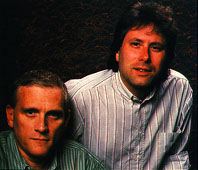
![]() Beauty and
the Beast won the Academy Awards for Best Original Score, and Best
Song (title track), and was the first -and so far, only- animated film
to be nominated for Best Picture!
Beauty and
the Beast won the Academy Awards for Best Original Score, and Best
Song (title track), and was the first -and so far, only- animated film
to be nominated for Best Picture!
![]() Blooper alert:
watch for the creeping bearskin rug and disappearing chair in the "Gaston"
reprise.
Blooper alert:
watch for the creeping bearskin rug and disappearing chair in the "Gaston"
reprise.
![]() Gaston's pupils
turn to skulls to suggest the outcome of his fall in his very last scene
Gaston's pupils
turn to skulls to suggest the outcome of his fall in his very last scene
![]() Obscure Cinematic
Homage Alert: watch for the baby carriage bouncing down the staircase in
the battle scene, a reference to a classic scene in Sergei Eisenstein’s
The
Battleship Potemkin.
Obscure Cinematic
Homage Alert: watch for the baby carriage bouncing down the staircase in
the battle scene, a reference to a classic scene in Sergei Eisenstein’s
The
Battleship Potemkin.
![]() Producer Don Hahn
said he had no interest in working on the 1997 holiday-themed sequel, The
Enchanted Christmas: "I don't get that involved with them because once
you spend three or four years of your life on a project you're ready to
move on," he said. "But I understand this is show business and these stories
have a life beyond what we put on the screen."
Producer Don Hahn
said he had no interest in working on the 1997 holiday-themed sequel, The
Enchanted Christmas: "I don't get that involved with them because once
you spend three or four years of your life on a project you're ready to
move on," he said. "But I understand this is show business and these stories
have a life beyond what we put on the screen."
![]() The legend of
Beauty
and the Beast is more than a thousand years old, but the most
famous version was written by Madame Marie Le Prince de Beaumont. Madame
Beaumont adapted her version from the "Contes Marins" of Madame Gabrielle
de Villeneuve. Madame Beaumont's version was printed in France in 1756
and in England in 1783. Linda Woolverton adapted Madame Beaumont's story
to a screenplay.
The legend of
Beauty
and the Beast is more than a thousand years old, but the most
famous version was written by Madame Marie Le Prince de Beaumont. Madame
Beaumont adapted her version from the "Contes Marins" of Madame Gabrielle
de Villeneuve. Madame Beaumont's version was printed in France in 1756
and in England in 1783. Linda Woolverton adapted Madame Beaumont's story
to a screenplay.
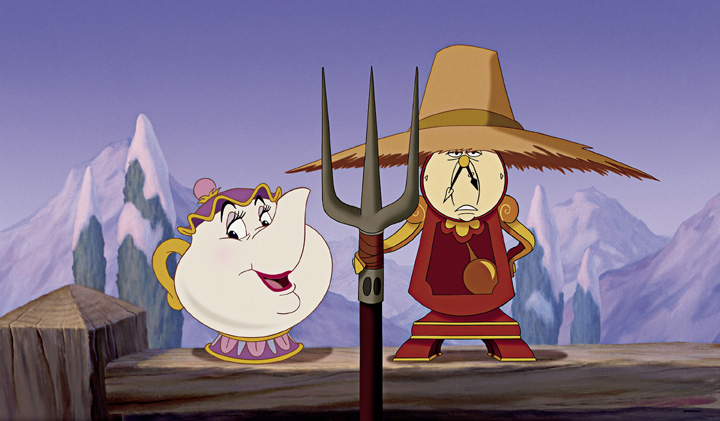 |
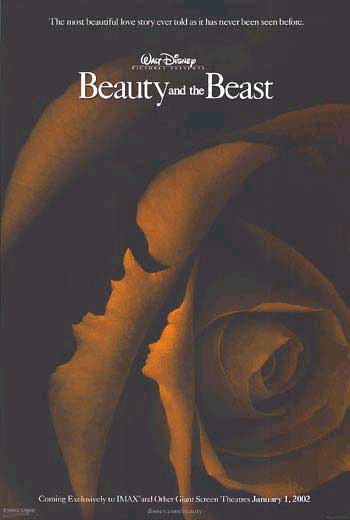 |
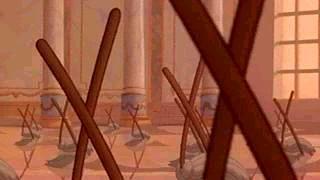 |
THE 10th ANNIVERSARY IMAX RELEASE
Beauty and the Beast was originally planned to be re-released in 1999, around the same time as DreamWorks' The Prince of Egypt.
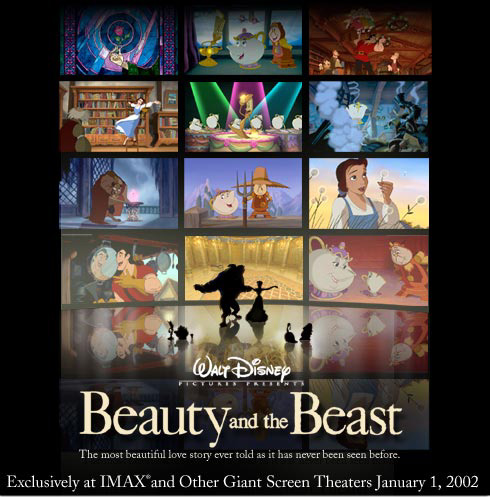 The
re-release was delayed by two years, and put on fast tracks again after
the huge success of the IMAX release of Fantasia
2000 (The Lion King then
Toy
Story are the next projects rumoured to get the IMAX treatment).
It was then scheduled for an IMAX release only to coincide with its 10th
anniversary and leave time to add six minutes of brand new footage -an
elaborate new musical number that Alan Menken and Howard Ashman wrote for
the movie back in 1989.
The
re-release was delayed by two years, and put on fast tracks again after
the huge success of the IMAX release of Fantasia
2000 (The Lion King then
Toy
Story are the next projects rumoured to get the IMAX treatment).
It was then scheduled for an IMAX release only to coincide with its 10th
anniversary and leave time to add six minutes of brand new footage -an
elaborate new musical number that Alan Menken and Howard Ashman wrote for
the movie back in 1989.
This song -"Human Again"- details the plans that Lumiere, Cogsworth, Mrs. Potts and the rest of the enchanted objects in the castle have made for themselves once the curse has been lifted. "We had storyboarded Human Again and stuck it in the movie -it was in the movie for a long time, but it was this big 11-minute song and we didn't know what to do with it, so we cut it down, then it was 7 minutes, then 5 minutes, then it was out!" This marks the first time Disney has ever animated a new sequence for a previously released feature film.
Producer Don Hahn explains how the decision was made to include this song:"About four years ago, Kirk and Gary and I were sitting around talking about the Star Wars Special Edition that had just come out and Kirk jokingly suggested, 'wouldn't it be fun to do a special edition of Beauty with 'Human Again' or new material in it?' When the head of Feature Animation said he thought it was a great idea, we stopped joking and began thinking about how we could actually do it. We had storyboarded the sequence for the original production, but completely reworked it for this special edition of the film."
For a while, a rumour that proved to be wrong had it that another stage song, "Home", which Belle sings in the Beast's dungeon (lyrics by Tim Rice), would also be added.
Disney animators had to 'tidy up' the messy castle after the musical sequence tells of an extensive spring clean. In the scene where Beast is having his fur clipped following a bath, animators had to straighten pictures, delete ripped curtains and wallpaper to add continuity to the new section.
The cost of re-do work is in the three million range. "The success of Fantasia 2000 clearly indicates that Disney entertainment and giant-screen showmanship go together like Mickey and Minnie, and this is a relationship we want to continue," Dick Cook, chairman of the Walt Disney Motion Pictures Group, said in a statement.
This enhanced version of Beauty and the Beast, for which animators
also refined characters and special effects, will be released in the giant-screen
IMAX format on January 1, 2002.
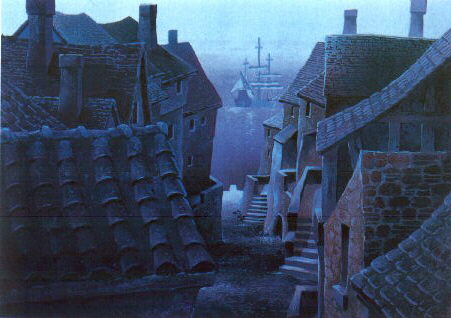 |
 |
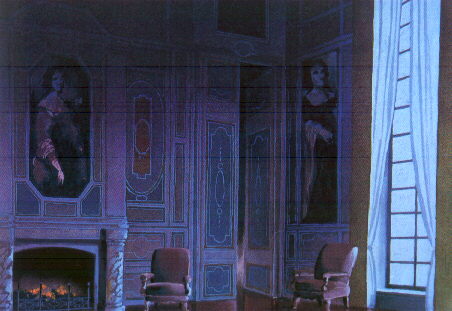 |
BEAUTY AND THE BEAST ON BROADWAY!
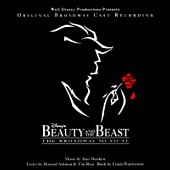 When
Disney CEO Michael Eisner saw Paige O'Hara (Belle) and Jerry Orbach (Lumiere)
perform musical highlights from Beauty and the Beast as part of an awards
presentation in New York City, he knew that audiences would embrace a live
stage version of the film. He turned to producer W. McTyre, director Robert
Roth and scenic designer Stan Meyer who immediately set out to find a way
to translate Beauty and the Beast to the Broadway stage. With the
help of costume designer Ann Hould-Ward, they soon determined how best
to make the enchanted objects from the film instantly recognizable withouth
impairing the actors' movements, but they were still stumped when it came
to recreating onstage such effects as the Beast's mystical transformation
back into a prince. For this, they turned to John Gaughan and Jim Steinmeyer
who had designed illusions for magicians David Copperfield and Siegfried
& Roy.
When
Disney CEO Michael Eisner saw Paige O'Hara (Belle) and Jerry Orbach (Lumiere)
perform musical highlights from Beauty and the Beast as part of an awards
presentation in New York City, he knew that audiences would embrace a live
stage version of the film. He turned to producer W. McTyre, director Robert
Roth and scenic designer Stan Meyer who immediately set out to find a way
to translate Beauty and the Beast to the Broadway stage. With the
help of costume designer Ann Hould-Ward, they soon determined how best
to make the enchanted objects from the film instantly recognizable withouth
impairing the actors' movements, but they were still stumped when it came
to recreating onstage such effects as the Beast's mystical transformation
back into a prince. For this, they turned to John Gaughan and Jim Steinmeyer
who had designed illusions for magicians David Copperfield and Siegfried
& Roy.
Beauty and the Beast was initially previewed on November 27, 1993 at the Music Hall Theatre in Houston, Texas. It officially opened at the Palace Theatre on April 18, 1994. Hould-Ward was awarded a 1994 Tony Award for "Best Costume Design" for her work on the musical.
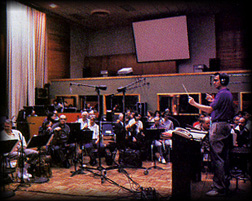 Seen
by over 15 million people worldwide, the musical can currently be seen
in New York, London, Buenos Aires, and Stuttgart. Productions have
been mounted in: Tokyo, Sapporo, Fukuoka, Temple, East Lansing, Los Angeles,
Melbourne, Sydney, Toronto, Vienna, Osaka, Mexico City, Nagoya, Minneapolis,
St. Louis, New Orleans, Washington, D.C., Detroit, Atlanta, Tampa, Seattle,
Portland, San Diego, Denver, Dallas, Chicago, Cleveland, Cincinnati, Boston,
Hartford, Ft. Lauderdale, and Louisville. During 10,549 performances,
audiences have seen 18 'Belles' (including singers Deborah -aka Debbie-
Gibson and Toni Braxton!) and 15 'Beasts.' The little-known song "A Change
in Me" was added to the show when Toni Braxton stepped in to star as Belle.
Seen
by over 15 million people worldwide, the musical can currently be seen
in New York, London, Buenos Aires, and Stuttgart. Productions have
been mounted in: Tokyo, Sapporo, Fukuoka, Temple, East Lansing, Los Angeles,
Melbourne, Sydney, Toronto, Vienna, Osaka, Mexico City, Nagoya, Minneapolis,
St. Louis, New Orleans, Washington, D.C., Detroit, Atlanta, Tampa, Seattle,
Portland, San Diego, Denver, Dallas, Chicago, Cleveland, Cincinnati, Boston,
Hartford, Ft. Lauderdale, and Louisville. During 10,549 performances,
audiences have seen 18 'Belles' (including singers Deborah -aka Debbie-
Gibson and Toni Braxton!) and 15 'Beasts.' The little-known song "A Change
in Me" was added to the show when Toni Braxton stepped in to star as Belle.
The hit show celebrated its 3,225th performance on March 13, 2002, thus
becoming the tenth longest-running Broadway show of all time, and the longest-running
American musical currently on Broadway!
|
||||||||||||